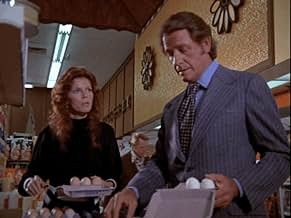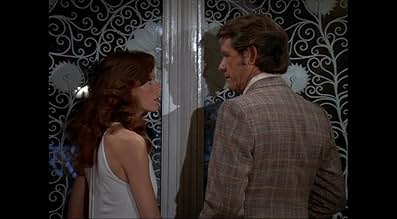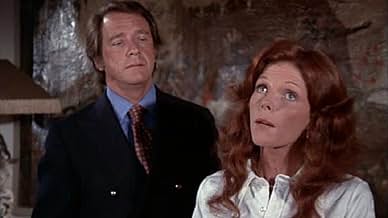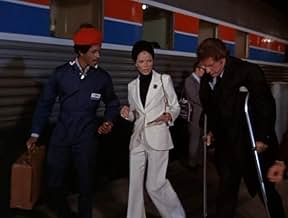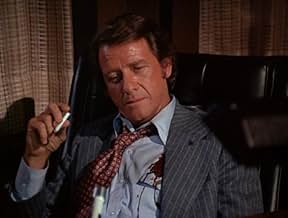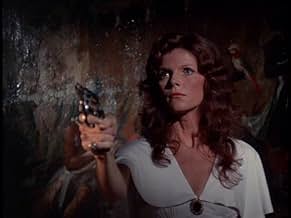Adicionar um enredo no seu idiomaA scheming wife lures an insurance investigator into helping murder her husband and then declare it an accident. The investigator's boss, not knowing his man is involved in it, suspects murd... Ler tudoA scheming wife lures an insurance investigator into helping murder her husband and then declare it an accident. The investigator's boss, not knowing his man is involved in it, suspects murder and sets out to prove it.A scheming wife lures an insurance investigator into helping murder her husband and then declare it an accident. The investigator's boss, not knowing his man is involved in it, suspects murder and sets out to prove it.
- Direção
- Roteiristas
- Artistas
Arnold F. Turner
- Redcap
- (as Arnold Turner)
Rand Brooks
- Conductor
- (não creditado)
Tom Curtis
- Charlie
- (não creditado)
John Furlong
- George
- (não creditado)
Avaliações em destaque
When Samantha Eggar (as Phyllis Dietrickson) answers the door of her house swathed in a towel, you realize that as competent an actress as Eggar may be, she doesn't have the hypnotic allure of Barbara Stanwyck. And it is not entirely Eggar's fault. In the original film, Wilder had Stanwyck not only appear in a towel, but she enters the scene on the second floor balcony of the house. And she doesn't "come out"; she appears, almost as if by magic. Walter Neff is staring up at her from below on the first floor. There is a reason for this. Stanwyck is much higher than Neff (Fred MacMurray) when they are first introduced. It is not just the towel. The towel adds to the seductive allure. Her pose is like a Greek Goddess overlooking her domain, and, in a strange way, you feel as if, from the start, she is actually controlling the entire situation. She has sexual, even magic, power. This person is no ordinary housewife. This person is a mystery with secrets hidden within.
Back to 1973. The remake has Crenna knock on the front door. Stanwyck's stand-in, Eggar, answers the door with a towel around her. There is no "appearance". She simply opens the door. The alluring superiority that grabs the audience at the first appearance of Stanwyck in 1944 is entirely absent in 1973. She opens the door with a towel around her. It may be sexy in a Charlie's Angels sort of way, but it's not nearly as mysterious. The filmmakers of the remake seem to misunderstand Wilder's point. The script may have said "Phyllis appears in towel" so the filmmakers of the remake simply follow the instructions and include the required towel. The point is not the towel. The point is the enigmatic quality of Phyllis, and the potential power she wields. Wilder gave her a towel to add to her mystique. The filmmakers of the remake gave her a towel because that's what Wilder did. And in the choice of shot, lost all of Phyllis' mystique.
Richard Crenna also seems miscast. He seems like he's "acting" and not really in the midst of the dilemma. Part of the problem is Crenna appears so much like a 70's actor. He can't get into the 1940's. When MacMurray first speaks into the microphone, sweat begins to drip from his face. No sweat on Crenna. And they also changed one of the crucial lines at the beginning. In the original, Neff says, "I didn't get the money, and I didn't get the woman." In the 1973 version, Crenna says, "I didn't get the money, and I didn't want the woman." Did the filmmakers completely misunderstand the entire point of the story? Or were they dumbing it down for a "television" audience?
This made-for-TV movie is a by-the-numbers rendition. All the sharp edge of the original is lost. The only stand-out, maybe, is Lee J. Cobb in the role made famous by Edward G. Robinson. But he cannot save the loss of intensity of the original. This 1973 boring remake is a forgettable TV-movie made probably by the same people who did "Gilligan's Island". They might as well have tried to remake "Citizen Kane" or "Gone with the Wind". If mediocrity is the best one can hope for, what's the point? The 1944 classic is a Film with a capital "F". This made-for-TV remake deserves an "F" grade, or, maybe a "D" for dumb.
Back to 1973. The remake has Crenna knock on the front door. Stanwyck's stand-in, Eggar, answers the door with a towel around her. There is no "appearance". She simply opens the door. The alluring superiority that grabs the audience at the first appearance of Stanwyck in 1944 is entirely absent in 1973. She opens the door with a towel around her. It may be sexy in a Charlie's Angels sort of way, but it's not nearly as mysterious. The filmmakers of the remake seem to misunderstand Wilder's point. The script may have said "Phyllis appears in towel" so the filmmakers of the remake simply follow the instructions and include the required towel. The point is not the towel. The point is the enigmatic quality of Phyllis, and the potential power she wields. Wilder gave her a towel to add to her mystique. The filmmakers of the remake gave her a towel because that's what Wilder did. And in the choice of shot, lost all of Phyllis' mystique.
Richard Crenna also seems miscast. He seems like he's "acting" and not really in the midst of the dilemma. Part of the problem is Crenna appears so much like a 70's actor. He can't get into the 1940's. When MacMurray first speaks into the microphone, sweat begins to drip from his face. No sweat on Crenna. And they also changed one of the crucial lines at the beginning. In the original, Neff says, "I didn't get the money, and I didn't get the woman." In the 1973 version, Crenna says, "I didn't get the money, and I didn't want the woman." Did the filmmakers completely misunderstand the entire point of the story? Or were they dumbing it down for a "television" audience?
This made-for-TV movie is a by-the-numbers rendition. All the sharp edge of the original is lost. The only stand-out, maybe, is Lee J. Cobb in the role made famous by Edward G. Robinson. But he cannot save the loss of intensity of the original. This 1973 boring remake is a forgettable TV-movie made probably by the same people who did "Gilligan's Island". They might as well have tried to remake "Citizen Kane" or "Gone with the Wind". If mediocrity is the best one can hope for, what's the point? The 1944 classic is a Film with a capital "F". This made-for-TV remake deserves an "F" grade, or, maybe a "D" for dumb.
This 1973 remake of the classic 1944 Billy Wilder film, "Double Indemnity," is a textbook example of how to destroy a great script. This grade-B TV fodder also illustrates the folly of remakes in general. While Hollywood has gone after greedy executives that colorize black-and-white films and sought disclaimers on wide-screen movies that are shown in pan-and-scan versions, the industry has ignored the hacks that insist on taking a classic film and diminishing it with a shoddy remake.
The first step in producing a bowdlerized version of a classic is to edit the script. The Billy-Wilder-Raymond-Chandler work was cut by a half hour to fit the finished film into a specified time-slot with room for commercials. Then update the production with bland, color photography, smart, upscale sets, and TV-familiar actors. Thus, the brand-new "Double Indemnity" eliminates the atmospheric black-and-white film-noir cinematography that enhanced the mood and characterizations of the original. Gone are the dusty, shadowy, claustrophobic sets that explained the protagonists' desires to escape their situations at whatever cost. Gone are the close bond between Keyes and Neff and the erotic attraction between Neff and Phyllis.
The look of Jack Smight's take on "Double Indemnity" is more "Dynasty" than film noir. Phyllis Dietrickson has a designer home to die for, and Neff's comfy pad would be hard to afford on an insurance salesman's salary, not to mention the sporty Mercedes convertible that he drives. Neither character has any apparent motive to murder for a paltry $200,000. If not money, then perhaps murder for love or lust? Not in this version. Richard Crenna shows little interest in Samantha Eggar, and their kisses are about as lusty as those between a brother and a sister. Crenna fails to capture the cynicism of Neff, and his attempts at double-entendre and sexual suggestiveness fall horribly flat. Eggar is little better and lacks sensuality and the depth to suggest the inner workings of a supposedly devious and manipulative mind. Only Lee J. Cobb manages a creditable performance as Keyes. Director Jack Smight and his three principals have all done much better work.
There was no conceivable reason to produce this wretched remake except to fill time in a broadcast schedule. There was no conceivable reason to resurrect this dud on DVD and package it with the original film except to fill out a double-disc package. The only lesson that can be learned from this misfire is that even a great script and great dialog can be ruined with poor casting, lackluster direction, and TV grade production values. The 1973 "Double Indemnity" should be titled "10% Indemnity," because viewing it only underscores the 100% perfection of the original movie.
The first step in producing a bowdlerized version of a classic is to edit the script. The Billy-Wilder-Raymond-Chandler work was cut by a half hour to fit the finished film into a specified time-slot with room for commercials. Then update the production with bland, color photography, smart, upscale sets, and TV-familiar actors. Thus, the brand-new "Double Indemnity" eliminates the atmospheric black-and-white film-noir cinematography that enhanced the mood and characterizations of the original. Gone are the dusty, shadowy, claustrophobic sets that explained the protagonists' desires to escape their situations at whatever cost. Gone are the close bond between Keyes and Neff and the erotic attraction between Neff and Phyllis.
The look of Jack Smight's take on "Double Indemnity" is more "Dynasty" than film noir. Phyllis Dietrickson has a designer home to die for, and Neff's comfy pad would be hard to afford on an insurance salesman's salary, not to mention the sporty Mercedes convertible that he drives. Neither character has any apparent motive to murder for a paltry $200,000. If not money, then perhaps murder for love or lust? Not in this version. Richard Crenna shows little interest in Samantha Eggar, and their kisses are about as lusty as those between a brother and a sister. Crenna fails to capture the cynicism of Neff, and his attempts at double-entendre and sexual suggestiveness fall horribly flat. Eggar is little better and lacks sensuality and the depth to suggest the inner workings of a supposedly devious and manipulative mind. Only Lee J. Cobb manages a creditable performance as Keyes. Director Jack Smight and his three principals have all done much better work.
There was no conceivable reason to produce this wretched remake except to fill time in a broadcast schedule. There was no conceivable reason to resurrect this dud on DVD and package it with the original film except to fill out a double-disc package. The only lesson that can be learned from this misfire is that even a great script and great dialog can be ruined with poor casting, lackluster direction, and TV grade production values. The 1973 "Double Indemnity" should be titled "10% Indemnity," because viewing it only underscores the 100% perfection of the original movie.
Jack Smight directed this TV remake of the original 1944 film, based on James M. Cain's novel, that stars Richard Crenna as Walter Naff, an insurance salesman seduced by a client's wife named Phyllis Dietrichson(played by Samantha Eggar) to murder her husband for the insurance money, with the double indemnity clause giving them twice the payout, though Walter's boss Barton Keyes(played by Lee J. Cobb) is suspicious of Phyllis, convinced she murdered her husband with the help of another man, not knowing that it's Walter... Needless and ineffectual remake still has a good cast and story, but no atmosphere or point at all.
It was hard to watch this film and be totally fair and objective since I am a big fan the original 1944 movie. That, to me and many others, is one of the greatest film noirs ever made. Realizing this is simply a shortened made-for-TV film and that most people had trashed it, I didn't expect much, but you can't help but compare this with the '44 film. Scene after scene, I found myself comparing what I was looking at it, and remembering how it played out with Fred MacMurray, Barbara Stanwyck, Edward G. Robinson and others. Now I was seeing these famous actors playing their famous roles replaced by Richard Crenna, Samantha Eggar and Lee J. Cobb.
When it was all over, I found it wasn't as bad as I had expected but it's no match for the 1944 original. The two main areas in which this made-for-TV film wasn't as good were (1) the electricity between the two leads was missing and (2) being only 90 minutes, they rushed the story with hardly time to develop the plot, characters and chemistry between those leads. Crenna and Eggar were flat, and simply no match for MacMurray and Stanwyck as "Walter Neff" and "Phyllis Dietrichson," respectively.
Where this re-make held its own was in the other characters, such as "Barton Keyes" and "Edward Norton." Cobb was terrific as Keyes and Robert Webber as Norton, head of the insurance company. It also was somewhat interesting to see the time frame changed, so the houses, cars, telephones, dictating machines, etc., were all early '70s instead of mid '40s. Otherwise, the storyline was very similar, just rushed.
However, one viewing was enough and I will happily go back to the original version for the rest of my viewings of this classic story and film.
When it was all over, I found it wasn't as bad as I had expected but it's no match for the 1944 original. The two main areas in which this made-for-TV film wasn't as good were (1) the electricity between the two leads was missing and (2) being only 90 minutes, they rushed the story with hardly time to develop the plot, characters and chemistry between those leads. Crenna and Eggar were flat, and simply no match for MacMurray and Stanwyck as "Walter Neff" and "Phyllis Dietrichson," respectively.
Where this re-make held its own was in the other characters, such as "Barton Keyes" and "Edward Norton." Cobb was terrific as Keyes and Robert Webber as Norton, head of the insurance company. It also was somewhat interesting to see the time frame changed, so the houses, cars, telephones, dictating machines, etc., were all early '70s instead of mid '40s. Otherwise, the storyline was very similar, just rushed.
However, one viewing was enough and I will happily go back to the original version for the rest of my viewings of this classic story and film.
This 1973 TV remake of the Billy Wilder classic is inferior to the original. Surprise!
First, the good things. Lee J. Cobb makes a terrific Barton Keyes. He's not as good as Edward G. Robinson, of course, but he's the only reason to watch this. This remake's only improvement over the original is that it cuts down the role of Lola Dietrichson, the step-daughter of the femme fatale, Phyllis Dietrichson.
And that's it for the good things.
The bad things are many. The director records everything in an indifferent manner: if you watched the film with the sound muted you'd hardly get the impression that anything especially interesting was happening. Because of modern bad taste, the film must be in color instead of black and white. Because of 1970s bad taste, all the sets are distractingly ugly. Walter Neff's expensive apartment, in particular, is hideous.
The modern setting hurts in a lot of small ways. Train trips were a bit more unusual in the 70s than in the 40s, so Mr. Dietrichson's decision to take a train seems more of a contrivance. Men stopped wearing hats, which prevents Walter from covering up his brown hair while posing as the white-haired Mr. Dietrichson. Women in mourning stopped wearing veils, which robs Samantha Eggar of a prop Barbara Stanwyck made splendid use of in a key scene. (Oddly, Lola still has the line where she reveals that her stepmother was trying on a black hat and veil before she had need of them.)
Stephen Bochco keeps much of the Billy Wilder-Raymond Chandler script the same. But he makes a lot of tiny, inexplicable changes to the dialogue which leave the script slightly flabby where once it was lean and muscular. Outrageously, the famous motorcycle-cop banter is gone, but look closely and you'll see what looks like a post-production cut where those lines should have been. Bochco may not be to blame.
Richard Crenna is passable as Walter Neff. What might have made this version tolerable is a really splendid Phyllis Dietrichson. Instead we get Samantha Eggar, who comes off like a standard-issue villainess from "Barnaby Jones." But who can blame Eggar? With a director who barely seems interested in what's happening in front of the camera, how could Barbara Stanwyck herself have come off well?
First, the good things. Lee J. Cobb makes a terrific Barton Keyes. He's not as good as Edward G. Robinson, of course, but he's the only reason to watch this. This remake's only improvement over the original is that it cuts down the role of Lola Dietrichson, the step-daughter of the femme fatale, Phyllis Dietrichson.
And that's it for the good things.
The bad things are many. The director records everything in an indifferent manner: if you watched the film with the sound muted you'd hardly get the impression that anything especially interesting was happening. Because of modern bad taste, the film must be in color instead of black and white. Because of 1970s bad taste, all the sets are distractingly ugly. Walter Neff's expensive apartment, in particular, is hideous.
The modern setting hurts in a lot of small ways. Train trips were a bit more unusual in the 70s than in the 40s, so Mr. Dietrichson's decision to take a train seems more of a contrivance. Men stopped wearing hats, which prevents Walter from covering up his brown hair while posing as the white-haired Mr. Dietrichson. Women in mourning stopped wearing veils, which robs Samantha Eggar of a prop Barbara Stanwyck made splendid use of in a key scene. (Oddly, Lola still has the line where she reveals that her stepmother was trying on a black hat and veil before she had need of them.)
Stephen Bochco keeps much of the Billy Wilder-Raymond Chandler script the same. But he makes a lot of tiny, inexplicable changes to the dialogue which leave the script slightly flabby where once it was lean and muscular. Outrageously, the famous motorcycle-cop banter is gone, but look closely and you'll see what looks like a post-production cut where those lines should have been. Bochco may not be to blame.
Richard Crenna is passable as Walter Neff. What might have made this version tolerable is a really splendid Phyllis Dietrichson. Instead we get Samantha Eggar, who comes off like a standard-issue villainess from "Barnaby Jones." But who can blame Eggar? With a director who barely seems interested in what's happening in front of the camera, how could Barbara Stanwyck herself have come off well?
Você sabia?
- CuriosidadesBilly Wilder (the co-writer and director of the original version, Pacto de Sangue (1944)) and Barbara Stanwyck (who played Phyllis in the original version) both saw the film in their respective homes when it broadcast. When it was over, Wilder immediately phoned Stanwyck, said, "Missy, they just didn't get it right," and hung up.
- ConexõesVersion of Pacto de Sangue (1944)
Principais escolhas
Faça login para avaliar e ver a lista de recomendações personalizadas
Detalhes
- Data de lançamento
- País de origem
- Idioma
- Também conhecido como
- Doble indemnización
- Locações de filme
- Empresas de produção
- Consulte mais créditos da empresa na IMDbPro
- Tempo de duração
- 1 h 14 min(74 min)
- Mixagem de som
- Proporção
- 1.33 : 1
Contribua para esta página
Sugerir uma alteração ou adicionar conteúdo ausente

